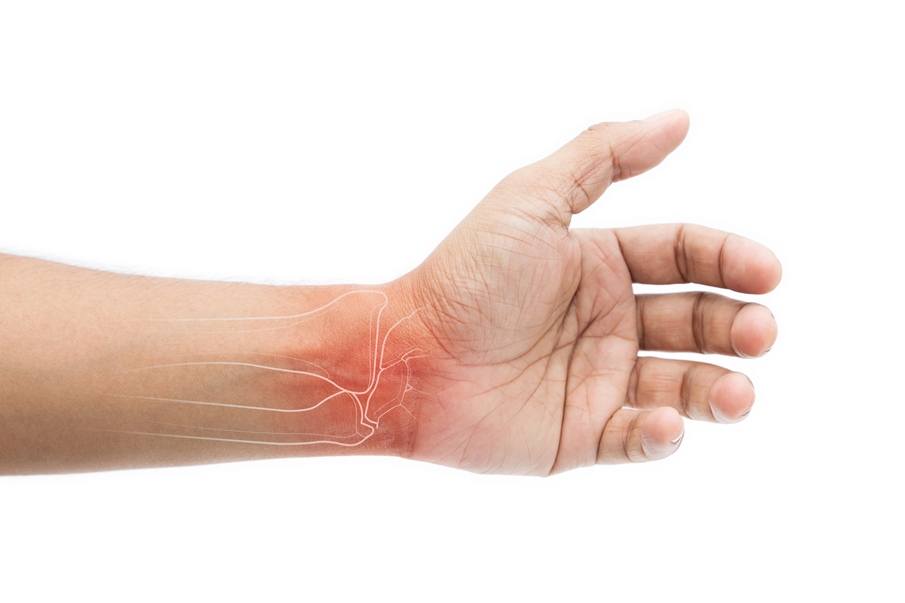Both tendonitis and carpal tunnel syndrome are painful conditions affecting the hand, wrist, and fingers, limiting your movement and ability to carry out and take part in everyday activities.
Tendons connect muscles to the bone and ultimately allow our bones and joints to move.
Tendonitis occurs when tendons in the hand become inflamed due to injury or irritation.
Carpal tunnel, however, is where the median nerve in the hand is compressed and irritated.
This is the most common type of nerve entrapment, where the narrow passage (the palm side of the wrist, or carpal tunnel), which is made up of ligaments, tendons, and bones, becomes swollen, leading to significant pain, and the patient requiring immediate carpal tunnel treatment.
In this post, we look at the causes of both tendonitis and carpal tunnel, symptoms to look out for, and treatment options available.
Identifying the difference between tendonitis and carpal tunnel
Tendonitis is inflammation in the tendons.
People experience carpal tunnel syndrome when the median nerve is placed under pressure (the main nerve running through a person’s wrist).
Tendonitis vs. carpal tunnel symptoms
Often, symptoms of carpal tunnel start slowly and gradually build and involve the palm side of the wrist.
The main symptoms of carpal tunnel include:
- Tingling or numbness in the fingers
- Burning sensation in the hand
- Pain in the palm of the hand, thumb, or first three fingers
- Weakness
- Shock sensations felt in fingers (pins and needles sensation)
- Swelling
The main symptoms of tendonitis include:
- Pain felt in your hand, fingers, or wrist, typically at the joint and on the backside of the wrist
- You may also struggle to move the joint
- The joint will feel warm and may be red in colour
- Hands or fingers will feel weak
If you are experiencing any signs or symptoms of tendonitis or carpal tunnel syndrome, it’s important that you speak with a professional wrist surgeon in Manchester as soon as possible.
Causes and treatment: tendonitis vs carpal tunnel syndrome
Causes of tendonitis
Tendonitis is often caused by repetitive damage to the hand. Most commonly found in athletes and those who are physically active, or where using your hands every day is part of your job.
For example, repetitive activities such as typing, texting, working on production lines, carrying out the same activity, playing sports such as tennis, paddle ball, etc where correct posture and hand movement is vital.
Tendonitis can also be caused by trauma, age, and a person’s weight.
Tendonitis is caused by anything that puts strain on your hands and wrists.
Causes of carpal tunnel syndrome
Carpal tunnel syndrome – compression/pressure is placed on the median nerve in the hand, which can be caused by repetitive flexing, genetics, rheumatoid arthritis, and even diabetes.
Treating tendonitis
Tendons can heal and repair themselves, provided they are given the opportunity to rest.
This means keeping your hand still and avoiding overuse and movement. A bandage or splint may be provided to offer a little more support.
Over-the-counter pain relief can help, and anti-inflammatory pain relievers can help reduce any swelling in the hand.
Icing the tendon may also be recommended to reduce swelling. Typically, the pattern follows, icing the tendon for 20 minutes and resting it for 2-3 hours.
In certain circumstances, you may be referred to an experienced physio to carry out specific exercises to help you regain full hand strength.
Recovery from tendonitis can take anywhere between two and three weeks.
Carpal tunnel treatment
Treatment for carpal tunnel syndrome will typically include braces and splints to help support the hand and reduce the movement while the hand heals.
Anti-inflammatory medication will also be recommended to reduce any swelling and help the patient manage pain relief.
In some cases, steroid injections may be considered to help release the pressure on the nerve, offer pain relief, and improve the patient’s hand movement.
If carpal tunnel has been diagnosed as severe, then surgery should be considered to help repair the damage and provide the patient with the best possible chance to regain full strength and movement in their hand.
If surgery is the best treatment option, recovery will vary between six to 12 months.
Hand surgeon in Manchester
Problems with the wrist and hand are what we at Ladan Hajipour specialise in.
As one of the specialist wrist and hand surgeons in Manchester, we work with our patients providing physical examinations, carrying out X-rays and MRIs to get to the root cause of the problem.
From here, we tailor treatment to your diagnosis.
Common hand infections can also contribute to pain and discomfort, and it’s essential to seek timely treatment to avoid complications.
If you’re experiencing pain or discomfort in the hand or wrist, this may require further investigation.
Please book an appointment with a member of our team today.
Book now.



